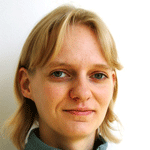Blogger: Kari Williamson 
Ultrasound is something most people know about, but did you know that some of the greatest achievements in the history of ultrasound happened in Trondheim? In May former and current ultrasound researchers gathered to celebrate milestones, birthdays – and to look into the future, towards 2025.
Highlights from Trondheim include:
- 1976: The PEDOF prototype is made (the first ultrasound apparatus measuring blood flow velocity).
- 1982: Cardiologist Liv Hatle and engineer Bjørn Angelsen publish the book “Doppler Ultrasound in Cardiology”, which is the first book of methods in the field.
- 1993: 3D ultrasound is developed for brain tumours. A collaboration between neurosurgeon Geirmund Unsgård and the technologists at the university.
- 2009: VScan – handheld ultrasound is a reality.
Most people know ultrasound through gynaecology and obstetrics – who hasn’t seen ultrasound images of babies? Professor and section chief at NTNU and St. Olavs Hospital, Sturla Eik-Nes, depicted the development in ultrasound from 1960 when the foetus was shown as lines on a graph, to coloured 3D images in 2000.
But the images are not there simply to look at the unborn baby, they are also of great medical importance. In the 80s one could measure the blood flow velocity of the baby using ultrasound, the blood flow between mother and placenta, and the blood flow between placenta and the baby. This made it possible for example to give blood transfusions to the baby in the womb.
Ultrasound has also been a crucial factor in making the foetus and unborn baby a patient with its own rights and specialists.
Diagnosis and surgery – via ultrasound
Ultrasound is not only used in gynaecology and obstetrics – another important area is cardiac diagnosis and surgery. It can be used to look at aneurisms on the aorta, and to see if the blood flows correctly through the heart.
During heart surgery one can use ultrasound probes to measure the blood flow velocity in blood veins, whereas visual ultrasound can be used to for example show the location of plaque in blood veins, which can cause stroke or heart attacks.
Trondheim was also the scene of the world’s first 3D ultrasound guided brain operation in 1997, two years after the establishment of the National Centre for 3D Ultrasound at NTNU and St. Olavs Hospital. Last year, the centre expanded to become the National Centre for Ultrasound and Image Guided Therapy.
Ultrasound as treatment
Something that may come as a surprise to those outside the medical sphere is that ultrasound can be used for more than looking at things inside the body or measuring blood flows – in the future we could also see it used in active treatment.
Several research projects are looking into direct drug delivery to sick organs by combining nanoparticles or micro-bubbles with ultrasound. The idea is to attach medicines or drugs such as chemotherapy to nanoparticles or micro-bubbles. When these reach the target area, ultrasound waves are applied to help these particles across from the blood veins into the sick organ or tissue, resulting in targeted treatment.
Ultrasound through the crystal ball
The ultrasound technology itself is still under development. Technicians here in Trondheim and across the world work on projects to improve image quality, make ultrasound easier to use, increase the levels of automation, and to reduce costs.
They are exploring whether today’s, and the future’s, computer technology could utilise more of the data coming from ultrasound images than humans are able to.
Stay tuned in to #NTNUMedicine to learn more about some of these projects!
An exhibition about ultrasound can be visited in Medical Museum at St. Olavs Hospital in October.
Happy birthday!
- 75 years: Kjell Arne Ingebrigtsen
- 60 years: Kjell Kristoffersen, Hans Torp, Arne Grip
- 50 years: Department of Physical Electronics
- 40 years: Doppler signals from the aorta
- 30 years: IREX/Vingmed Meridian (Grand Plan, Sys. I)
- 20 years: Digital beamformer, Sys. V)
- 10 years: 4D ultrasound, electronic transducer


